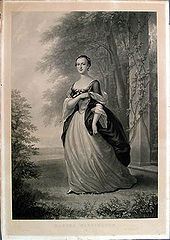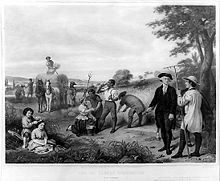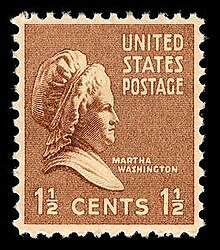Martha Washington
Martha Dandridge Custis Washington (born June 13, 1731 in Williamsburg , Virginia Colony ; † May 22, 1802 in Mount Vernon , Virginia ) was the wife of the first US President, George Washington, from April 30, 1789 to March 4, 1797 the first first lady of the USA . She was also known as Lady Washington .
Life
Martha ("Patsy") Dandridge was the eldest of eight children of John Dandridge (1701–1756) and Frances Jones (1710–1785), who had married in 1730, and came in June 1731 in their parents' estate Chestnut Grove in New Kent County to World. Martha had three brothers and four sisters: John Dandridge (1733–1749), William Dandridge (1734–1776), Bartholomew Dandridge (1737–1785), Anna Marie “Fanny” Dandridge Bassett (1739–1777), Frances Dandridge (1744– 1757), Elizabeth Dandridge Aylet Henley (1749–1800) and Mary Dandridge (1756–1763). On her father's side, Martha came from Oxfordshire , where most of her ancestors had been farmers in the 16th and 17th centuries and some of them had achieved considerable prosperity. In 1715, her father Dandridge had emigrated to the Virginia colony with his older brother . He was successful as a trader and acquired a substantial amount of land in the east of the colony, which he leased or resold at a profit. He also served as a secretary in the county administration and ran a plantation . Historians assign the Dandridge family to the "lower planter aristocracy " of Virginia. Martha's mother, Jones, was born in the Thirteen Colonies with ancestors from Wales and England . Jones' grandfather, Rowland Jones from Welsh, was probably the first of this family branch to emigrate to America. The Joneses included a number of distinguished pastors and religious leaders.
Martha received an education typical of an 18th century girl, which was limited to housekeeping and social skills.
At the age of 18 she married the wealthy Daniel Parke Custis , who was twenty years her senior . The couple lived at the White House plantation after the wedding . They had four children together, two of whom died in infancy: Daniel jun. (1751–1754), Frances (1753–1757), John Parke Custis “Jacky” (1754–1781) and Martha “Patsy” Parke Custis (1756–1773). Her husband Daniel Sr. died in 1757.
On January 6, 1759, the widow Martha Dandridge Custis married the then Colonel George Washington. The marriage remained childless. However, after the death of Martha's son Jacky, the couple took care of his four children. Two of the children, George Washington Parke Custis ( Wash ) and Eleanor Parke Custis Lewis ( Nelly ), lived with them permanently. Her daughter Patsy died of epilepsy as a teenager.
In her marriage, she cared for the well-being and happiness of her husband and children or grandchildren from the start. When his political career took George Washington to the battlefields of the American Revolution , she traveled with him. The management of the presidential budget in the alternating capitals of New York and Philadelphia had the aim that the newly established republic of Europe was recognized as equal. Martha was considered a warm hostess who made the guests feel welcome.
In 1797, the Washingtons said goodbye to public life and returned to their Mount Vernon manor . After Washington's death in 1799, Martha burned all of her letters. She died of a high fever in 1802 and was buried next to her husband in Mount Vernon.
Martha Washington and Slavery

Martha Washington grew up at a time when slavery was legal in the American colonies . There is no record of how she felt about this from an ethical and moral point of view.
After the death of her first husband in 1757, the widow inherited a third of his property as a dowry share and also the income from it for use for life. She administered the other two thirds for her children, who were still underage. The complete Custis possession included several plantations and farms over a total of 27 square kilometers and 285 enslaved men, women and children belonged to these properties. In 1759 Martha's share consisted of 75 slaves.
After her marriage to George Washington in 1759 he became the legal administrator of the custodian property. However, records indicate that Martha Washington herself continued to buy supplies, pay staff, and make other decisions. Although the Washington had control of the entire property, they only received Martha's third income.
Washington used his wife's great wealth to acquire land. He tripled the size of Mount Vernon from 2,650 acres (1757) to 8251 acres (1787). For more than 40 years the "dowry" slaves farmed his lands. The Washingtons did not sell custisland or slaves as they administered them for Martha's only surviving child, John.
Seven of the nine slaves that President Washington brought to the then capital for household chores (1790–1800) were "dowry" slaves. Pennsylvania had begun abolition of slavery as early as 1780, but non-residents were allowed to keep slaves for six months. In order to protect their "property", the Washington had their slaves moved in and out of the state on a rotating basis so that this six-month rule, which would have been a legal possibility for release, could not come into effect. Washington had considered that if the "dowry" slaves had been freed through his negligence, he would have been liable for the custodian inheritance up to the value of these slaves.

Martha Washington was very upset when her servant Oney Judge fled the Philadelphia household during Washington's second term. In an interview in 1840, Oney Judge herself said that the first lady had intended to give the young woman as a wedding gift to her granddaughter, Eliza Custis . Oney initially hid with free black friends in town and later fled to the north. Patricia Brady wrote in her biography of Martha Washington in 2005:
“Martha felt responsible for the naive girl under her protection, especially since her mother and sister were waiting for her back in Mount Vernon. What she never understood was that (Oney) […] had a simple desire to be free. Ona, as she liked to call herself, wanted to live where she liked, work what she liked and learn to read and write [...]. Ona Judge had respect for Martha [...], but she saw no future as a slave for herself and her children. "
In March 1797, the last week of the Washington family in Philadelphia, their chef Hercules also escaped from slavery. His daughter, who lived in Mount Vernon, told a visitor that she was glad her father was free.
In 1799, there were at least a dozen married couples among the 153 "dowry" slaves and 124 slaves of Washington . Washington decided in his last will that his own slaves would be released after his death. His hope that he could acquire the "dowry" slaves from the Custiserbe and also free them came to nothing. His attempt to give the slaves the opportunity to be hired in order to free themselves from slavery through labor also failed. To spare Martha the spectacle of having to watch the slave families being torn apart, Washington further stipulated in his will that the slaves were not to be released until after Martha's death.
Martha released Washington's slaves on January 1, 1801. Abigail Adams visited Mount Vernon two weeks earlier and wrote: “ Many of those who are liberated have married with what are called the dower Negroes, so that they all quit their (family) connections, yet what could she do? ”(German:“ Many of those who were liberated are married to so-called dowry negroes, so they lose all their (family) connections, so what should they do? ”) Adams cited as the motive for the earlier release of the Slaves that Martha no longer felt safe in her life, as George Washington’s will stated that she would be released upon her death. After Martha's death in 1802, her four grandchildren (the children of Jacky Custis) inherited the "dowry" slaves. Elisha, the only slave she owned, left her to her grandson George Washington Parke Custis .
Author Henry Wiencek wrote in his book An Imperfect God: George Washington, His Slaves, and the Creation of America that the slave Ann Dandridge was Martha Washington's sister and slave at the same time. This illegitimate half-sister (date of birth unknown) was a quarter African, a quarter Cherokee Indian, and half white. Ann Dandridge had one child by Martha's son (and Ann's nephew) John Parke "Jack" Custis. He bases this claim on original documents discovered in the Mount Vernon files and at the Virginia Historical Society and stated that previous historians have ignored these evidence. According to Wiencek, this incident was one of several that led George Washington to label slavery as "repulsive" and perhaps influenced the later decision to release all of his slaves. The existence of the slave Ann Dandridge is also recognized in Helen Bryan's 2002 book Martha Washington: First Lady of Liberty . Bryan states that this "shadow sister" is said to have been Martha's age and that they played together as children.
Commemoration
In 1886 there was a dollar banknote with a portrait of Martha Washington. You and Pocahontas are the only women ever depicted on American banknotes.
In 1902 Martha was the first American woman to be immortalized on a US postage stamp .
A ship built by Russell & Co. in 1907 for the Trieste shipping company Austro-Americana in Glasgow , which operated between Trieste and New York, was named Martha Washington .
Frank Miller named the heroine of his comic book series Give Me Liberty after her, which is probably no coincidence, since the series takes place during a fictional civil war in the future.
literature
- Non-fiction
- Jeanne E. Abrams: First Ladies of the Republic: Martha Washington, Abigail Adams, Dolley Madison, and the Creation of an Iconic American Role. NYU Press, New York 2018, ISBN 978-1-4798-8653-1 .
- Robert P. Watson: Martha Washington. In Katherine AS Sibley (Ed.): A Companion to First Ladies. Wiley-Blackwell, Chichester 2016, ISBN 978-1-118-73222-9 , pp. 6-19.
- Patricia Brady: Martha Washington. American Life. Penguin, New York 2006, ISBN 978-0-14-303713-2 .
- Helen Bryan: Martha Washington. First Lady of Liberty. John Wiley, New York 2002, ISBN 978-0-471-15892-9 .
- Robert P. Watson: Martha Washington. In the same (ed.): American First Ladies. Salem Press, Pasadena 2002, LCCN 2001-042903 , pp. 9-18.
- Patricia Brady: Martha Dandridge Custis Washington. In Lewis L. Gould (Ed.): American First Ladies: Their Lives and Their Legacy. Routledge, New York 2001, ISBN 0-415-93021-9 , pp. 1-11.
- Joseph E. Fields (Ed.): Worthy Partner: The Papers of Martha Washington. Praeger, Westport 1996, ISBN 978-0-313-28024-5 .
- Fiction
- Mary Higgins Clark : Mount Vernon Love Story. A Novel of George and Martha Washington. Paperback version of the first edition from 1969. Simon & Schuster, New York 2002, ISBN 978-0-7432-0630-3 .
Web links
- Martha Washington. In: FemBio. Women's biography research (with references and citations).
- Biography on the White House website (archived)
- Martha Washington in the Miller Center of Public Affairs of the University of Virginia (English)
- Lena Christin Ohm: May 22nd, 1802 - Anniversary of Martha Washington's death on May 22nd, 2017 WDR ZeitZeichen (Podcast)
Individual evidence
- ^ Robert P. Watson: Martha Washington. In Katherine AS Sibley (Ed.): A Companion to First Ladies. Wiley-Blackwell, Chichester 2016, ISBN 978-1-118-73222-9 , pp. 6-19; here: p. 6f.
- ^ Two 1840s interviews with Oney Judge
- ↑ Brady, p. 209.
- ^ Last Will and Testament of George Washington.
- ↑ “ In the state in which they were left by the General, to be free at her death, she did not feel as tho her Life was safe in their hands, many of whom would be told that it was [in] their interest to get rid of her. She therefore was advised to set them all free at the close of the year. ”(Abigail Adams to Mary Cranch, December 21, 1800)
- ^ Bank Note Museum - United States of America, banknotes with Martha Washington
| personal data | |
|---|---|
| SURNAME | Washington, Martha |
| ALTERNATIVE NAMES | Dandridge Custis Washington, Martha (full name) |
| BRIEF DESCRIPTION | first American first lady |
| DATE OF BIRTH | June 13, 1731 |
| PLACE OF BIRTH | Williamsburg , Virginia |
| DATE OF DEATH | May 22, 1802 |
| Place of death | Mount Vernon , Virginia |




